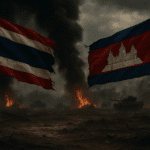A massive earthquake measuring 8.8 on the Richter scale struck the Far East waters off Russia’s Kamchatka Peninsula on July 30, 2025, triggering widespread tsunami warnings across the Pacific region. The quake occurred around 3:00 UTC at a shallow depth of 19.3 kilometers, with its epicenter located approximately 119 kilometers southeast of Petropavlovsk-Kamchatsky. This powerful undersea tremor, categorized as a megathrust event along the Kuril-Kamchatka subduction zone, was the strongest to hit the region in decades echoing the seismic intensity of the devastating 1952 quake.
As seismic waves rippled through the Pacific, immediate tsunami warnings were issued for Russia, Japan, Hawaii, the U.S. West Coast, and several island nations across South America and Oceania. In Russia, coastal towns such as Severo-Kurilsk were directly impacted, with waves reaching heights of 3 to 5 meters, damaging roads, flooding fish processing facilities, and sweeping vessels inland. Emergency evacuations were swiftly carried out, and local officials credited the warning systems for minimizing casualties.
In Japan, the quake sparked fears of a repeat of the 2011 disaster. Authorities responded rapidly, issuing evacuation orders for nearly 2 million residents along the northern Pacific coast. Tsunami waves of up to 1.3 meters were recorded along the shores of Hokkaido and Honshu, and though the physical damage remained limited, a tragic fatality occurred when a woman’s car veered off a cliff during evacuation efforts. In a precautionary move, workers were briefly evacuated from the Fukushima nuclear plant, though no radiation leaks or structural issues were reported.
Across the Pacific, the United States also braced for impact. In Hawaii, tsunami waves measuring up to 1.7 meters struck the coast, leading to widespread evacuations, port closures, and temporary chaos. Cruise ships evacuated ports early, leaving hundreds of passengers stranded, while emergency shelters were quickly set up in schools and community centers. On the U.S. mainland, particularly along California, Oregon, and Washington, smaller waves under 1 meter reached the coast. Though damage was minimal, coastal residents received evacuation advisories and were urged to avoid beaches and low-lying areas until the threat had passed.
In South America, particularly in Chile, authorities ordered what they described as the “most massive evacuation ever,” relocating over 1.4 million people from coastal zones. Tsunami waves ranging from 1.1 to 3 meters were recorded, causing flooding in several towns. Similar alerts extended to Ecuador’s Galápagos Islands, Fiji, Samoa, and parts of New Zealand.
Despite the quake’s enormous magnitude, the actual tsunami impact was far less destructive than feared. Experts and emergency agencies praised the effectiveness of early warning systems like those managed by the Pacific Tsunami Warning Center (PTWC). Decades of investment in tsunami preparedness, improved infrastructure, and public education campaigns played a critical role in limiting the disaster’s toll. A key difference from past calamities, such as the 2004 Indian Ocean tsunami or Japan’s 2011 earthquake, was the swift global response and high evacuation compliance in affected areas.
However, the situation remains dynamic. Seismologists warn of potential aftershocks, some possibly reaching magnitude 7.5, and noted that volcanic activity in the region could increase. Indeed, later the same day, the Klyuchevskoy volcano, one of the world’s most active erupted, adding to the challenges faced by Russian emergency services.
As the Pacific basin continues to recover from the shock, governments are assessing the event as both a wake-up call and a testament to the power of international coordination in disaster mitigation. While nature’s forces remain unpredictable, the events of July 30 showed that preparation, technology, and cooperation can dramatically reduce the human and economic toll of such massive natural disasters.


















